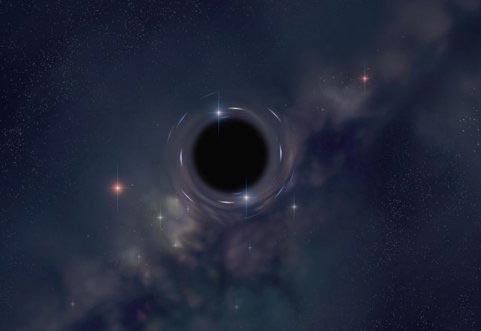Earth is closer to the black hole than expected
Dutch astronomers measured the relative distance between the earth and the nearest black hole.
Peter Jonker, a scientist from SRON Space Research Institute, the Netherlands, says black holes are named V404 Cygni, 7,800 light-years from Earth. But scientists have always thought that the distance between V404 Cygni and the earth is twice that.
Meanwhile, the distance from our planet to the center of the Milky Way is 26,000 light-years, while the closest star to the sun is 4.2 light-years away.
The Space site said, Jonker and colleagues calculated the distance to V404 Cygni by measuring radio radiation from the black hole and the dead star that created it.
The outer layers of the star are being sucked into the black hole. The cloud of rotating dust and gas, forming a plasma disc (the state of matter in which the ionized substances are strong, the majority of the atom and molecule remaining only the nucleus) glows around the black hole before it disappear. In the process of turning and creating physical plasma discs emit lots of X-rays and radio waves.

Illustration
Using an international radio telescope system called High Sensitivity Array, the team measured the change in the black hole's parallax.
The team said that the scientific community could not accurately measure the distance between the earth and the V404 Cygni due to the presence of gas dust in the universe. Dust can absorb light and cause diffraction, so the error can be up to 50%. Meanwhile the new measurement error is less than 6%.
The study is published in the December issue of The Astrophysical Journal.
A black hole (or black hole) is an area in space that has a large gravitational field so that its gravity does not allow any form of matter - including light - to escape its boundary (legs heaven event), except the possibility of material loss from black holes thanks to quantum tunnel effect. The matter that wants to escape the black hole must have a velocity of escape greater than the speed of light in a vacuum, which cannot happen within the framework of the theory of relativity where the speed of light in vacuum is the speed of the world. The largest achievable term of all physical forms.
Scientists believe that black holes formed from the collapse process into the hearts of stars. Black holes have at least three times the mass of the Sun. However, many supermassive black holes can have millions or billions of solar masses. Many people liken black holes to greedy demons, because the amount of matter they can swallow is endless.
- No one expected, there were these weird black holes
- The first time I took a picture of a black hole three million times bigger than Earth
- What happens when the Earth falls into a black hole?
- Discover the mystery of the most exotic black holes in the universe
- Observe the black hole with the naked eye
- 740 million light years away is a completely different universe of black holes
- Discovering 'super black holes' is 12 times bigger than the Sun.
- The discovery of the
- Scientists have observed 1000 times the material that the Sun has just emerged from a black hole
- Star 'starving' black hole is a billion light years from Earth
- What if a black-sized black hole attacked the Earth?
- The supermassive black hole closest to Earth glows intensely
 Van Allen's belt and evidence that the Apollo 11 mission to the Moon was myth
Van Allen's belt and evidence that the Apollo 11 mission to the Moon was myth The levels of civilization in the universe (Kardashev scale)
The levels of civilization in the universe (Kardashev scale) Today Mars, the sun and the Earth are aligned
Today Mars, the sun and the Earth are aligned The Amazon owner announced a secret plan to build a space base for thousands of people
The Amazon owner announced a secret plan to build a space base for thousands of people